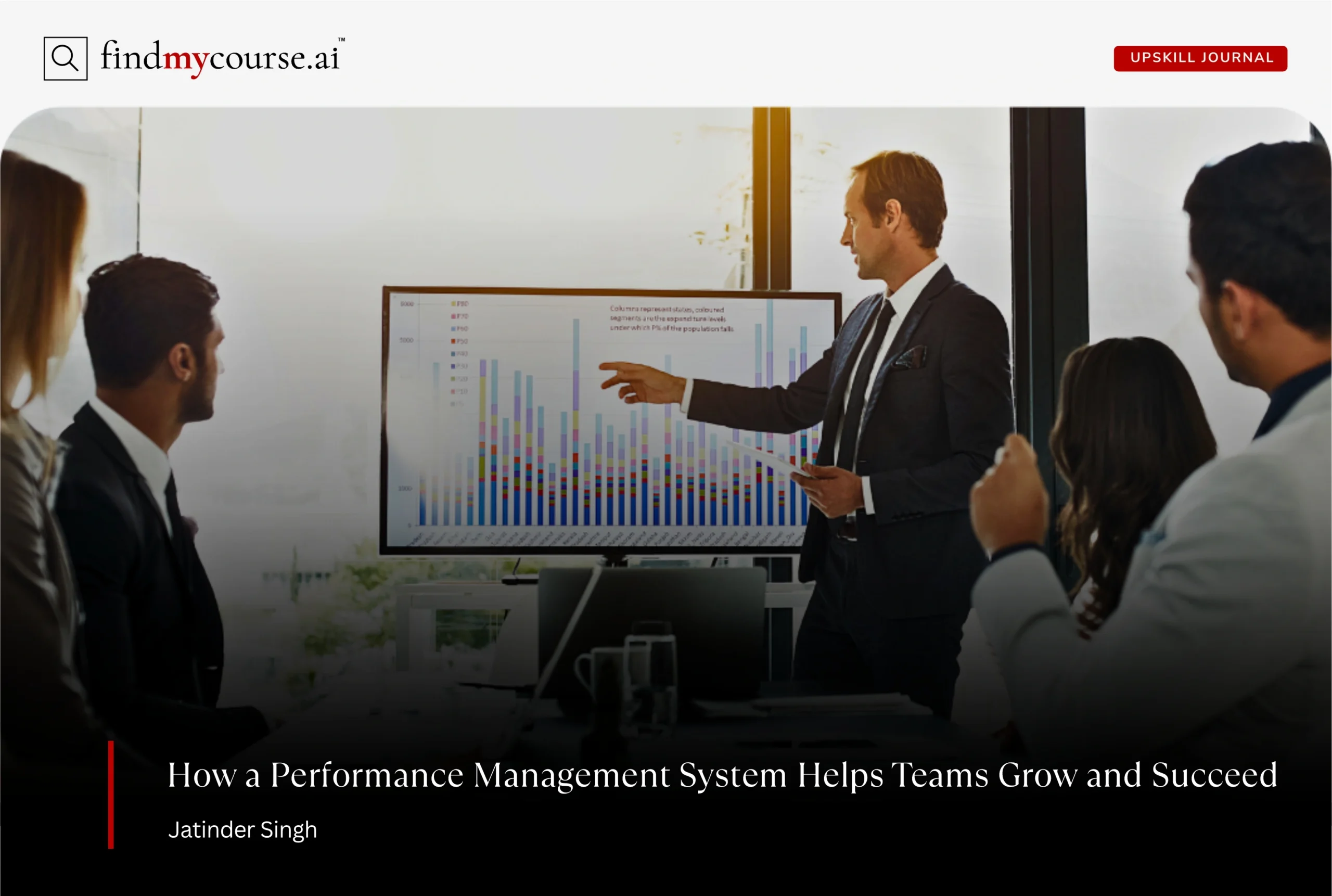In a world where change is constant and expectations evolve faster than ever, organizations need more than an annual review to help employees grow and perform at their best. They need a structured yet flexible approach that aligns goals, measures progress, and fuels professional growth. This is where a performance management system comes in. This system acts as the backbone of organizational success as it ensures every individual’s effort contributes meaningfully to larger goals while enabling upskilling opportunities. In this guide, we’ll break down what such a system entails, how the performance management process works, and the best ways to build one that inspires people—not just evaluates them.
What Is a Performance Management System?
A performance management system is a structured framework that helps organizations set goals, monitor progress, and assess employee performance continuously. It connects individual objectives to organizational priorities and creates a consistent, transparent process for evaluation and development. Unlike traditional annual appraisals, which often focus solely on past performance, modern performance management systems emphasize real-time feedback, coaching, and continuous growth. They encourage conversations about improvement and learning instead of criticism or ranking.
A strong system integrates technology, leadership, and culture. It empowers managers to act as mentors and guides rather than just evaluators. For employees, it offers clarity about expectations and opportunities to shine. When implemented thoughtfully, a performance management system becomes less about judgment and more about shared success.
Understanding the Performance Management Process
A well-designed performance management process follows a continuous, five-stage cycle that connects people, goals, and growth.
1. Planning and Goal-Setting: The process begins with clarity. Managers and employees collaborate to set measurable, meaningful goals that align with team and organizational priorities.
2. Continuous Monitoring: Regular check-ins replace one-off reviews. Ongoing conversations ensure progress stays on track, challenges are addressed early, and feedback remains timely.
3. Coaching and Development: As performance data reveals strengths and gaps, managers provide targeted coaching, mentoring, or training—turning evaluation into opportunity.
4. Evaluation and Review: At defined intervals, progress is assessed against goals, behaviors, and results to gain a balanced view of both achievement and effort.
5. Recognition and Reward: Finally, accomplishments are celebrated—through promotions, incentives, or appreciation—reinforcing motivation and accountability.
Together, these stages create a dynamic loop of planning, learning, and improvement that helps individuals evolve while driving organizational success.
Types of Performance Management Systems
Not all organizations use the same model. Here are the most common types of performance management systems, along with their key features, advantages, and potential challenges.
| Type of System | Core Description | Key Advantages | Possible Drawbacks | Best Suited For |
| 1. Rating-Based Systems | Traditional models using numeric or categorical scores (e.g., 1–5 or “Exceeds Expectations”) to measure performance against set criteria. | • Simple to implement and compare • Useful for pay and promotion decisions • Provides clear data | • Misses qualitative factors • May foster unhealthy competition • Risk of bias or oversimplification | Large corporations or regulated sectors needing standardized evaluations |
| 2. Continuous Feedback Systems | Focus on regular, informal check-ins instead of annual reviews to support agility and communication. | • Encourages transparency and real-time improvement • Strengthens manager–employee trust • Enables quick adjustments | • Demands consistent engagement • Harder to track long-term data • Requires open, feedback-friendly culture | Agile, modern firms valuing collaboration and adaptability |
| 3. 360-Degree Feedback Systems | Gathers input from peers, subordinates, and managers for a well-rounded performance view. | • Holistic insights • Reduces single-source bias • Promotes teamwork | • Time-intensive • Feedback quality may vary • Can invite personal bias | Organizations focused on leadership growth and team culture |
| 4. Goal-Driven or OKR-Based Systems | Built around Objectives and Key Results (OKRs) to align measurable goals with strategic outcomes. | • Boosts alignment and accountability • Enhances motivation • Drives focus on results | • May overlook soft skills • Feels rigid if goals shift • Needs frequent tracking | Startups and goal-oriented, performance-driven teams |
| 5. AI-Enabled or Data-Driven Systems | Uses analytics and machine learning to detect trends, reduce bias, and predict development needs. | • Increases objectivity • Identifies high-potential talent • Provides predictive insights | • Dependent on data accuracy • May raise privacy issues • Needs robust tech infrastructure | Digital-first or data-driven organizations seeking scalability |
Implementing a Performance Management System
Introducing or redesigning a performance management system isn’t just a technical project—it’s a cultural shift. It requires thoughtful planning, open communication, and a genuine commitment to improvement. Whether you’re starting from scratch or upgrading an outdated process, implementation should focus on alignment, clarity, and sustainability rather than speed.
Below are five essential steps to guide a smooth and successful rollout.
1. Define Clear Objectives
Before choosing any tools or templates, clarify why you’re introducing a new system. Ask key questions:
- What problem are we trying to solve?
- What outcomes do we expect—better alignment, higher engagement, or fairer evaluations?
- How will success be measured?
Having clear, measurable objectives will help you design a system that supports your organization’s mission rather than becoming a compliance exercise. When people understand the “why,” they’re far more likely to embrace the “how.” To structure these objectives effectively, tools like Betterworks and Perdoo can help align organizational goals and visualize performance outcomes from the start.
2. Select the Right Framework
Next, decide on the structure and tools that best fit your culture and scale. Smaller organizations may prefer flexible, conversation-based systems, while larger ones might need standardized platforms for consistency and reporting.
Choose a framework that balances structure with adaptability. Consider how goals will be set, how feedback will be delivered, and how data will be collected. Most importantly, ensure the process feels human and relevant—not mechanical.
If your organization already uses technology platforms for HR or learning management, look for ways to integrate them. A connected system reduces duplication and keeps data centralized, making performance insights more actionable. Modern tools like Lattice and BambooHR make this integration seamless, combining feedback, goal tracking, and analytics in one space.
3. Pilot the Process First
Rather than launching company-wide right away, test the system with a smaller group or single department. A pilot allows you to identify gaps, fine-tune workflows, and collect honest feedback without overwhelming the entire organization.
During the pilot:
- Encourage participants to share what works and what feels confusing.
- Observe how managers deliver feedback and how employees respond.
- Track early outcomes such as engagement levels, goal clarity, and time spent on reviews.
Once insights are gathered, make adjustments before scaling up. This approach not only minimizes disruption but also builds confidence and ownership among early adopters. To support pilot data collection and analysis, platforms like Culture Amp or Officevibe provide easy ways to capture employee sentiment and performance insights.
4. Train Managers and Employees
Even the most thoughtfully designed system can fail if people don’t know how to use it effectively. Training is the bridge between process and practice.
Provide workshops and toolkits that teach managers how to set SMART goals, conduct coaching conversations, and give constructive feedback. Emphasize empathy and active listening—two skills that define great leadership.
For employees, create guides that explain how the system benefits them, how to document progress, and how to request feedback proactively. When everyone feels equipped and informed, adoption becomes smoother and more natural.
Training should be ongoing, not a one-time event. Regular refreshers keep the system relevant as roles evolve and expectations change.
5. Measure, Review, and Evolve
Implementation doesn’t end once the system goes live—it’s the beginning of a continuous learning journey. Regularly evaluate how well the performance management process is working.
Ask yourself:
- Are employees more engaged and aligned?
- Do managers find it easier to track progress and provide feedback?
- Are we seeing measurable improvement in performance outcomes?
Collect both quantitative data (e.g., completion rates, performance trends) and qualitative feedback (e.g., user experience, perceived fairness). Use these insights to refine your system every few months.
Remember, a performance management system is never “finished.” It should evolve as your organization grows, new technologies emerge, and employee expectations shift. Tools like Power BI and Tableau can visualize performance data over time, making it easier to identify trends and guide smarter decisions.
Common Pitfalls to Avoid
Even with good intentions, some systems fail to deliver value. Here are common mistakes to steer clear of:
- Overemphasis on Ratings: Reducing people to numbers often breeds competition instead of collaboration.
- Infrequent Reviews: Annual reviews alone can’t capture the full picture or drive real improvement.
- Poor Communication: If employees don’t understand how evaluations work, they’ll see the system as unfair or irrelevant.
- Ignoring Development Needs: Focusing only on outcomes, not skills, limits long-term growth.
- One-Size-Fits-All Approach: Different roles require different criteria—flexibility is essential.
Avoiding these traps ensures your system feels empowering, not mechanical.
Conclusion
A performance management system is more than a process—it is a catalyst for growth, engagement, and organizational alignment. By setting clear goals, providing continuous feedback, and recognizing achievements, it empowers employees to develop skills, embrace challenges, and upskill consistently. Managers become coaches, guiding progress rather than just evaluating results, while teams gain clarity and motivation. When implemented thoughtfully, such a system transforms performance management from a routine administrative task into a strategic tool that drives individual potential, fosters collaboration, and fuels long-term organizational success. And if you need more information or have questions related to these systems, just ask our AI assistant any time.



One thought on “Performance Management Systems Explained”
Comments are closed.